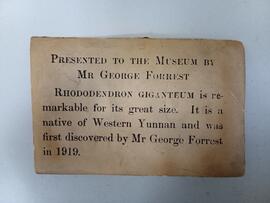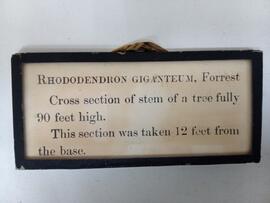RBGE Museum label used in the display of George Forrest's Rhododendron giganteum / Rhododendron protistum stating: 'Presented to the Museum by Mr George Forrest. Rhododendron Giganteum is remarkable for its great size. It is a native of Western Yunnan and was first discovered by Mr George Forrest in 1919.'
Royal Botanic Garden Edinburgh (Creator)Museum label that was used on display with Forrest's Rhododendron giganteum / Rhododendron protistum.
Label states 'Rhododendron Giganteum, Forrest. Cross section of stem of a tree fully 90 feet high. This section was taken 12 feet from the base.'
Section of Rhododendron protistum [Rhododendron giganteum] felled by George Forrest's collectors in March 1931.
Forrest, GeorgeThis is a small series of items relating to the section of Rhododendron giganteum - now named Rhododendron protistum found and collected by George Forrest and his collectors in Yunnan, China on the 15th March 1931. The series consists of the specimen itself, and two of its museum labels.
For more information: (right click, open link in new tab) https://stories.rbge.org.uk/archives/14186
one map used in Forrest's article describing the geography and people of the Upper Salween during his visit there with Consul George Litton in late 1905. The article was published by the Royal Geographical Society in 1908 with this accompanying map, and again by the National Geographical Society in 1910.
Royal Geographical SocietyDescription of valley from Hsia Kuan [Xiaguan] to Shang Kuan [Shangguan] and city of Tali [Dali]. Hsia Kuan is a customs station and the most important business centre in Western Yunnan, with population of over 12,000, all of whom are engaged in trade; important centre of opium production, with some trade in Szechuanese, Cantonese and foreign goods; Litton advocates establishment of a Chinese agency at Hsia Kuan by some foreign firm. Tali plain narrow and fertile, densely populated mainly by Minchia people, very mixed with Chinese; description of their dress and customs, temple of the Goddess of Mercy and legend of the monster Yao Kwei. Principal officials and administration of city of Tali, its main buildings, walls towers and streets, insanitary conditions and prevalence of disease; population c.5,000; much of city in ruins following ‘the rebellion’ [Mohammedan [Muslim] rebellion]; rough sketch of earthen city wall with brick facing. Details of goods for sale include gold, some from Tibet but mainly obtained from the Yangtse.
Forrest, GeorgeIncomplete letter from George Forrest, China Inland Mission, Talifu, to Clementina Traill dated 28 March 1905.
The letter is incomplete, comprising pages numbered 1-12, 13 and 15. Forrest continues his description of Tali [Dali] where marble is the main product; details of production process; wood for furniture mainly walnut and other trades include silversmiths, coppersmiths and horn workers. Description of house construction, method of brickmaking, ornamentation and arrangement of buildings; female clothing, make-up and footbinding, men’s dress and hairstyles. Education consists almost entirely of learning Confucian classics; parental power of life and death over children; prevalence of opium smoking and suicide; wide variety of food available. Includes rough sketch of a two-storey house and of a pouch for holding cash.
Plants referred to: on pp.12-13: Apricot; Bean; Cabbage; Carrot; Filbert; Fig; Gleditschia; Grape; Lemon; Mandarin orange; Pea; Peach; Pear; Persimmon; Pomegranate; Potato; Rice; Sapindus; Sultana; Turnip; Walnut
Incomplete letter from George Forrest, Mission Apostolique, Tsekou, to Clementina Traill dated 28 April 1905.
The letter is incomplete, comprising 16 complete pages and fragments of pages 17 and 19. Forrest describes his journey from Talifu [Dali] to Tsekou [Cigu], going north by Chien Chuan; overnight camp in temple and first row with Chinese; loss of mule in gully and refusal of muleteers to go on; rescue by party of Lissoos who helped Forrest continue ascent through deep snow. Arrival at Wei Hsi; meeting with Pere Bourdonnec of the Mission Apostolique in Tibet and startling news of revolt amongst the lamas in the north; Tsekou mission in danger and consul Litton on his way with troops to defend it; murder of missionaries and Christian natives at Atunze and Batang; Forrest advised to remain at Wei Hsi but continued to Tsekou which he found practically in a state of siege. ‘All this is a bit of a nuisance as I cannot go far away from the place and therefore cannot do much collecting. Fortunately there isn’t much to be done at present – at least in the seed line, and, although during my journey from Tali I collected specimens of over 100 species, yet these were only flowering in the lower parts of the valleys. Here very few flowers are in bloom now, the mountains being still heavily coated with snow.’
Plants referenced: Pine (passim)
Letter from George Forrest, Talifu [Dali] to Isaac Bayley Balfour, 'Regius Keeper', Royal Botanic Garden Edinburgh, dated 7 January 1905.
Forrest writes to say he has added a further 8 specimens to the consignment referred to in his previous letter.
The letter is slightly fire damaged and marked with red ink.
Letter from George Forrest, China Inland Mission, Talifu [Dali], to Isaac Bayley Balfour, 'Regius Keeper', Royal Botanic Garden Edinburgh, dated 22 March 1905.
Forrest writes to give details of his disappointing journey south. He never reached Mengtze as Mr Wilkinson preferred Forrest to assist him in laying out ground at the new consulate outside Yunnanfu [Kunming]. Regrets small number of seeds and specimens. Reports that a letter thrown over the mission gate warns of a plot to burn down the mission and murder the missionaries; the attack to take place during the great spring fair on the 15th of the 3rd Chinese moon, i.e. 19th April. ‘Missionaries are going to take no steps in the matter … and say that if anything does take place they forbid me to shoot, but -.’
Plants referenced: Camellia; Rhododendron; Saxifrage
The letter is fire damaged with some loss.


